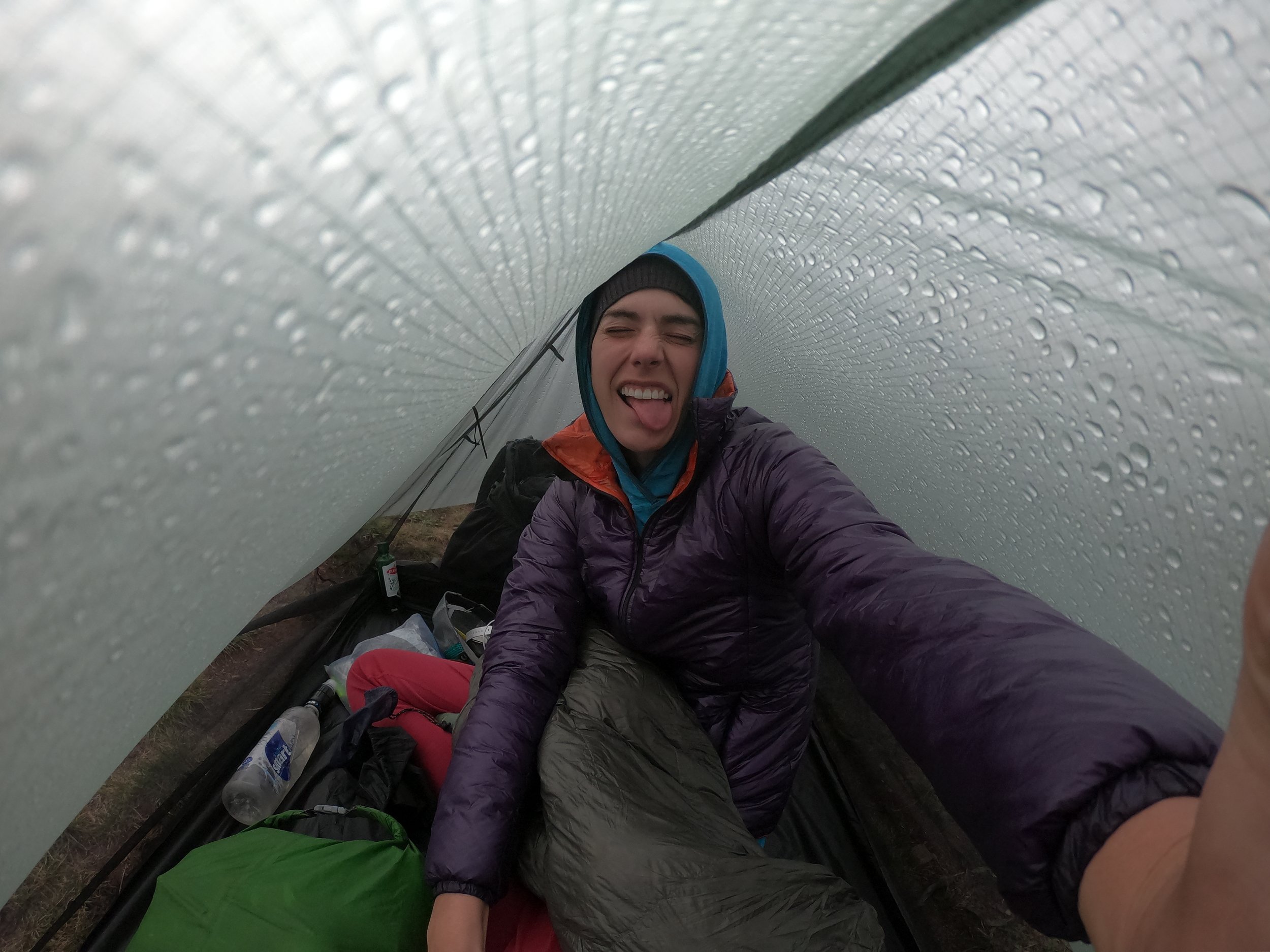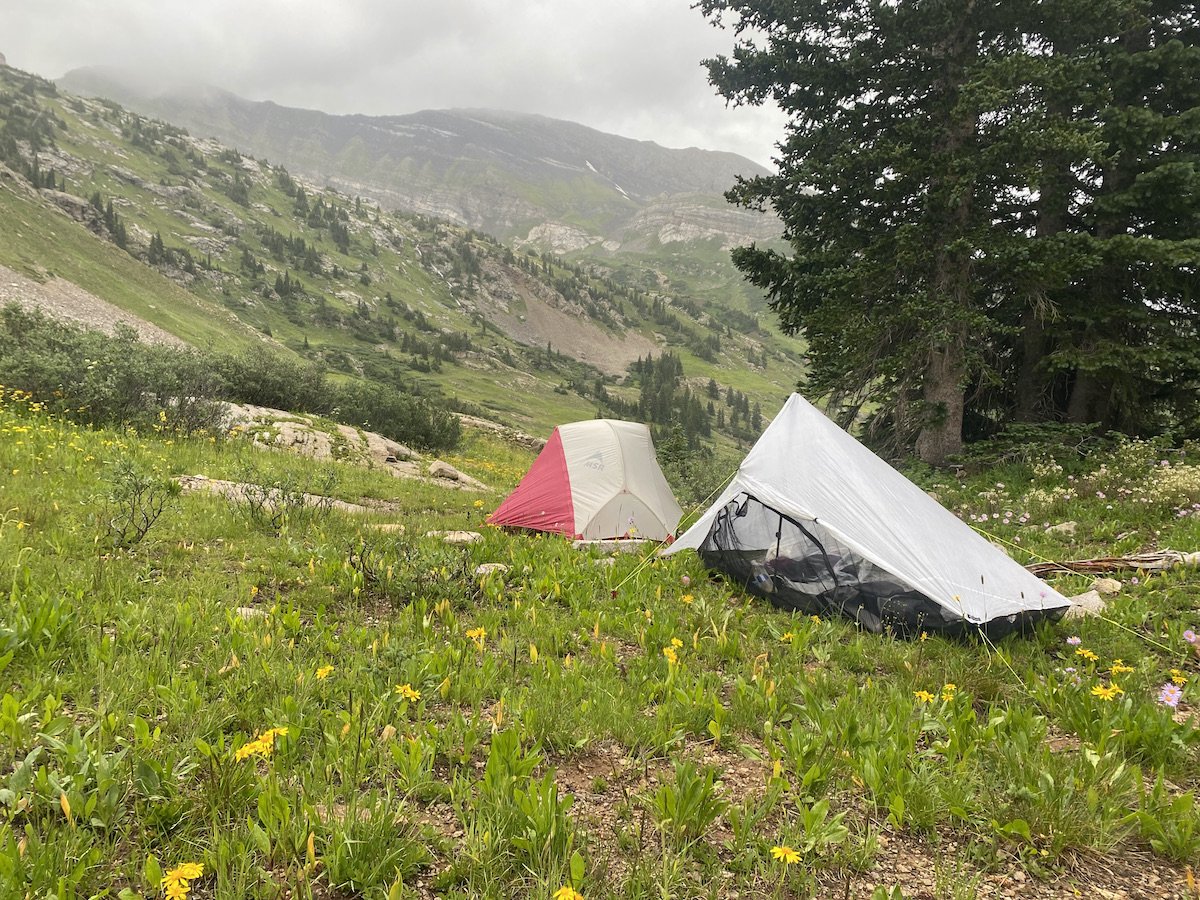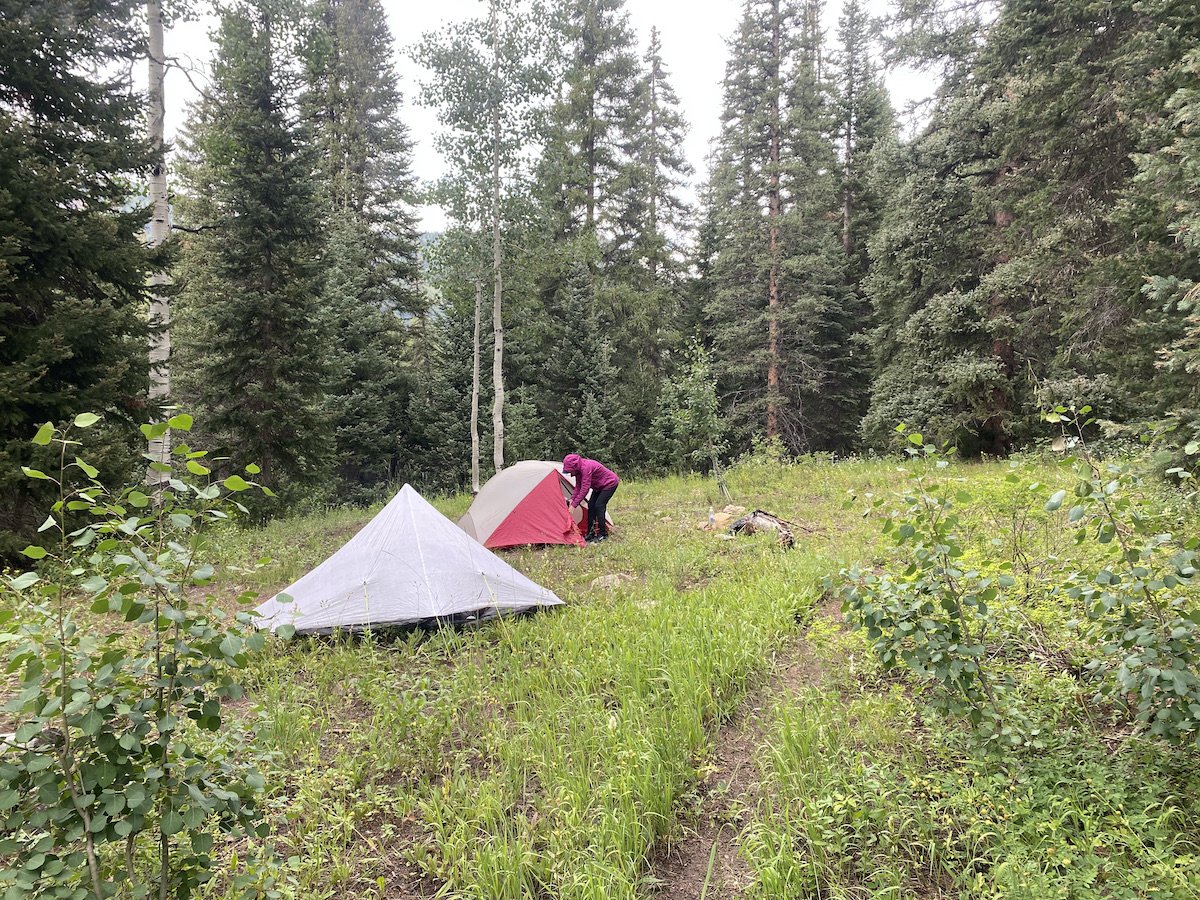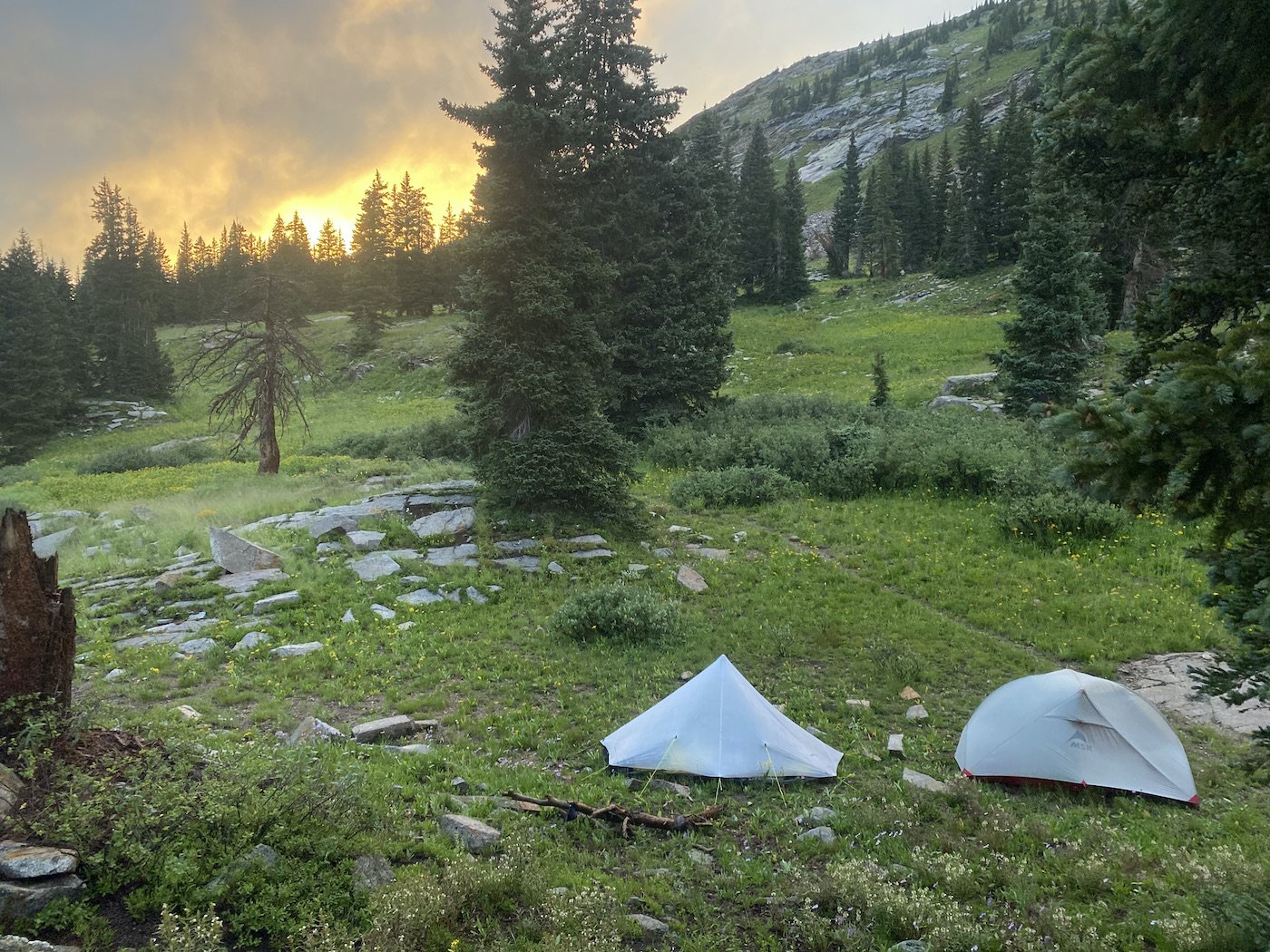Whatever the Weather: Backpacking in the Rain
When I am planning a backpacking trip, I do not always have the luxury of choosing the perfect “weather window”. I get after it when I can, and sometimes that means recreating in less than ideal conditions…
In this post, I will talk about the top 4 ways to ensure you have a good time backpacking, whatever the weather.
But first, I will address one particularly auspicious weather event. If you spend any amount of time in the mountains—whether you do your hiking in the Appalachian Mountains, or the Colorado Rockies—you are sure to encounter:
Thunderstorms
Part of the beauty of spending a long weekend in the mountains is the unpredictability; the mountains churn up the weather, literally.
As the sun bakes their rocky slopes on long summer days, the cooler air in the sky above interacts with the warm air currents rising from the mountains below, yielding “spicy” conditions.
July and August in the Rocky Mountains tend to have the highest incidence of afternoon thunderstorms. Thunder season can definitely extend into September and, if you are lucky, you may even experience “thunder snow” in late fall and winter.
Just because you begin your day beneath clear skies, doesn’t mean your day will end that way. Tall, cumulonimbus clouds build up quickly, and it is best practice to NOT be above tree line when they let loose around 1 or 2PM.
Unless you have gotten a weather report about the relative humidity and moisture content of the air, it can be hard to guess what the weather will do, so it’s smart to be prepared for all scenarios.
Are you ready for the top 4 ways to have a better time in “bad” weather?
Way #1: Check the forecast, “know before you go”
If you are traveling in mountainous terrain, mid-summer, there is always a chance of thunderstorms in the afternoon, and trust me, it is absolutely terrifying to sprint across a 12,000ft pass in a hailstorm, with lightning cracking just seconds a way.
If you have the opportunity to check the weather before you embark, that information can be really helpful when it comes to planning your days on trail—but know this, weather changes at the drop of a hat.
One way to stay up to date on conditions while you are out is to carry a satellite device, like a Garmin InReach; with such a device, you can request weather reports from your location in the field.
There are limitations with this method of forecasting, however; if you are in a densely treed area, or the clouds have already rolled in, the gps signal could be weak, your weather report may take a long time to get to you, and it might be wildly inaccurate.
When all else fails, the best advice I’ve ever been given for judging conditions is to “just look up”, aka: be aware of your surroundings and practice constant vigilance.
Remaining aware of your surroundings looks like:
Checking the forecast before you leave the trailhead & paying attention to changes in the weather while you are out
Avoid being above tree-line after 1PM; plan to clear the pass in the morning—or much later in the evening after the storms pass—during monsoon season
Trust your gut; if the clouds are building, choose a lower route or consider waiting them out
Way #2: Pack clothing for all conditions
Sometimes, it just rains.
Even if you “know before you go” and have a weather report in hand predicting clear skies, it is so important to be prepared for rain and cold.
I always carry a raincoat and warm layers when I go backpacking, even in the middle of the summer.
Rain is not inherently dangerous the way lightning is, but if you cannot not keep yourself warm in a steady downpour, you might be at risk of developing hypothermia.
Hypothermia occurs as your body temperature falls below 95 degrees F—it could be 60 F and raining and if you are caught out unprepared, what would have been a mildly uncomfortable situation, could turn into a dangerous one.
Packing for success looks like:
Bringing layers for all types of weather:
a raincoat *at a minimum*
additionally: gloves, a beanie, a fleece layer, and a synthetic puffy jacket
I also recommend a pair of thin long underwear bottoms for camp and emergencies, even in the middle of summer
Being comfortable with the layers you pack:
make sure all of your layers work together as a team, that your fleece fits under your puffy, under your raincoat, etc.
Packing smart:
Keep layers accessible in your backpack
Don’t burry important items that you will need throughout the day at the bottom of your pack—it is really hard to dig for a pair of gloves with damp, numb hands
Way #3: Hot food, hot drinks—but if you can’t have hot food, at least make sure it’s good food
There are a variety of lightweight camping stoves on the market, my two favorites are:
the MSR PocketRocket® 2.6oz (plus the weight of your pot & fuel canister)
the MSR WindBurner® 15.3oz (plus the weight of the fuel canister)
But if you decide to forgo the stove, as I sometimes do—to save precious ounces and space to carry more food—at least make sure the food you are carrying is calorie dense and delicious!
Hard cheeses and salami
Tortillas, crackers and chips
Peanutbutter and granola
Ramen and instant potatoes (which can be cold-soaked in a plastic jar)
Chocolate, dried fruit, and nuts
You can even splurge on weight and carry fresh fruit, avocados, carrots, and hummus!
Packing foods that will sustain you on cold, dreary days, make the experience all the more enjoyable and memorable (in a good way!)
And finally, way #4: “Embrace the suck”
I have been given this advice by every worthwhile outdoors person I’ve ever met!
So what does it mean?
“Embracing the suck” means understanding and accepting that all the adventures worth having are going to involve a certain level of discomfort, struggle and suffering.
We don’t seek out remote places—vast wilderness areas, high mountain passes, technical peaks, alpine lakes, or long and winding trails because they are comfortable, we go because we are looking for an experience worth having, we are looking to be “changed”.
And the wilderness will change us for the better, if we let it.
It could rain, it might hail, you may get sun burn and blisters, your shoulders may ache, you will probably be covered in a dusty layer of zinc, grit, and sweat by the time the adventure is through, but I promise you, those hardships are the makings of the best kind of adventure.
If you can teach yourself to smile in the rain, to protect your well-being even in the most extreme conditions, you will look back on particularly challenging adventures with pride and joy.
Rain puts “fire on the mountain” (as seen in the photo below), and adversity puts a fire in the heart.
Embracing the suck looks like:
practicing good self-care
remaining positive and solution oriented in the face of adversity
offering support to your trip-mates
being mentally prepared for weather to happen, because it will









